Dissertation: Business Processes Transformation in Small Enterprises
VerifiedAdded on 2023/02/02
|29
|10862
|37
Thesis and Dissertation
AI Summary
This dissertation examines the transformation of business processes within Small to Medium Enterprises (SMEs), focusing on the case of Angst Supermarket. The research aims to analyze the characteristics of SMEs and the processes required for their growth into successful large-scale businesses. It explores the impact of SMEs on the global market, compares various business growth strategies, and investigates website development tools. The dissertation includes a literature review discussing the significance of SMEs in the modern economy, the impact of digital technologies, and various methodologies. It outlines the research methodology, objectives, and questions, along with the rationale and scope of the study. The structure includes chapters on introduction, literature review, background research, requirements, design, product evaluation, process evaluation, and conclusion. The study also emphasizes the importance of business process improvement, planning, and effective management for SME growth and competitiveness, with a focus on leveraging technology, particularly website development, to enhance business operations and expansion.

DISSERTATION
Paraphrase This Document
Need a fresh take? Get an instant paraphrase of this document with our AI Paraphraser
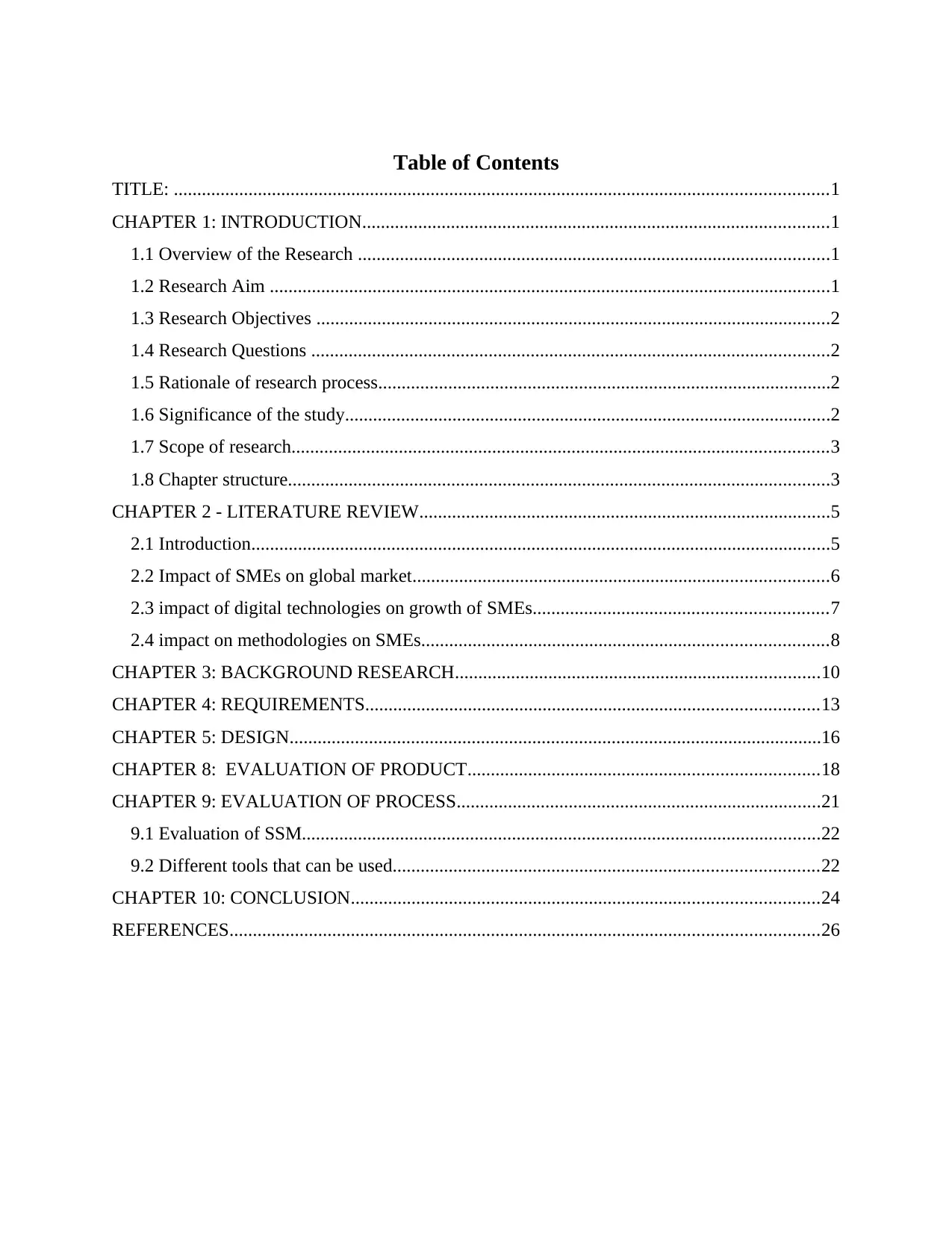
Table of Contents
TITLE: ............................................................................................................................................1
CHAPTER 1: INTRODUCTION....................................................................................................1
1.1 Overview of the Research .....................................................................................................1
1.2 Research Aim ........................................................................................................................1
1.3 Research Objectives ..............................................................................................................2
1.4 Research Questions ...............................................................................................................2
1.5 Rationale of research process.................................................................................................2
1.6 Significance of the study........................................................................................................2
1.7 Scope of research...................................................................................................................3
1.8 Chapter structure....................................................................................................................3
CHAPTER 2 - LITERATURE REVIEW........................................................................................5
2.1 Introduction............................................................................................................................5
2.2 Impact of SMEs on global market.........................................................................................6
2.3 impact of digital technologies on growth of SMEs...............................................................7
2.4 impact on methodologies on SMEs.......................................................................................8
CHAPTER 3: BACKGROUND RESEARCH..............................................................................10
CHAPTER 4: REQUIREMENTS.................................................................................................13
CHAPTER 5: DESIGN..................................................................................................................16
CHAPTER 8: EVALUATION OF PRODUCT...........................................................................18
CHAPTER 9: EVALUATION OF PROCESS..............................................................................21
9.1 Evaluation of SSM...............................................................................................................22
9.2 Different tools that can be used...........................................................................................22
CHAPTER 10: CONCLUSION....................................................................................................24
REFERENCES..............................................................................................................................26
TITLE: ............................................................................................................................................1
CHAPTER 1: INTRODUCTION....................................................................................................1
1.1 Overview of the Research .....................................................................................................1
1.2 Research Aim ........................................................................................................................1
1.3 Research Objectives ..............................................................................................................2
1.4 Research Questions ...............................................................................................................2
1.5 Rationale of research process.................................................................................................2
1.6 Significance of the study........................................................................................................2
1.7 Scope of research...................................................................................................................3
1.8 Chapter structure....................................................................................................................3
CHAPTER 2 - LITERATURE REVIEW........................................................................................5
2.1 Introduction............................................................................................................................5
2.2 Impact of SMEs on global market.........................................................................................6
2.3 impact of digital technologies on growth of SMEs...............................................................7
2.4 impact on methodologies on SMEs.......................................................................................8
CHAPTER 3: BACKGROUND RESEARCH..............................................................................10
CHAPTER 4: REQUIREMENTS.................................................................................................13
CHAPTER 5: DESIGN..................................................................................................................16
CHAPTER 8: EVALUATION OF PRODUCT...........................................................................18
CHAPTER 9: EVALUATION OF PROCESS..............................................................................21
9.1 Evaluation of SSM...............................................................................................................22
9.2 Different tools that can be used...........................................................................................22
CHAPTER 10: CONCLUSION....................................................................................................24
REFERENCES..............................................................................................................................26
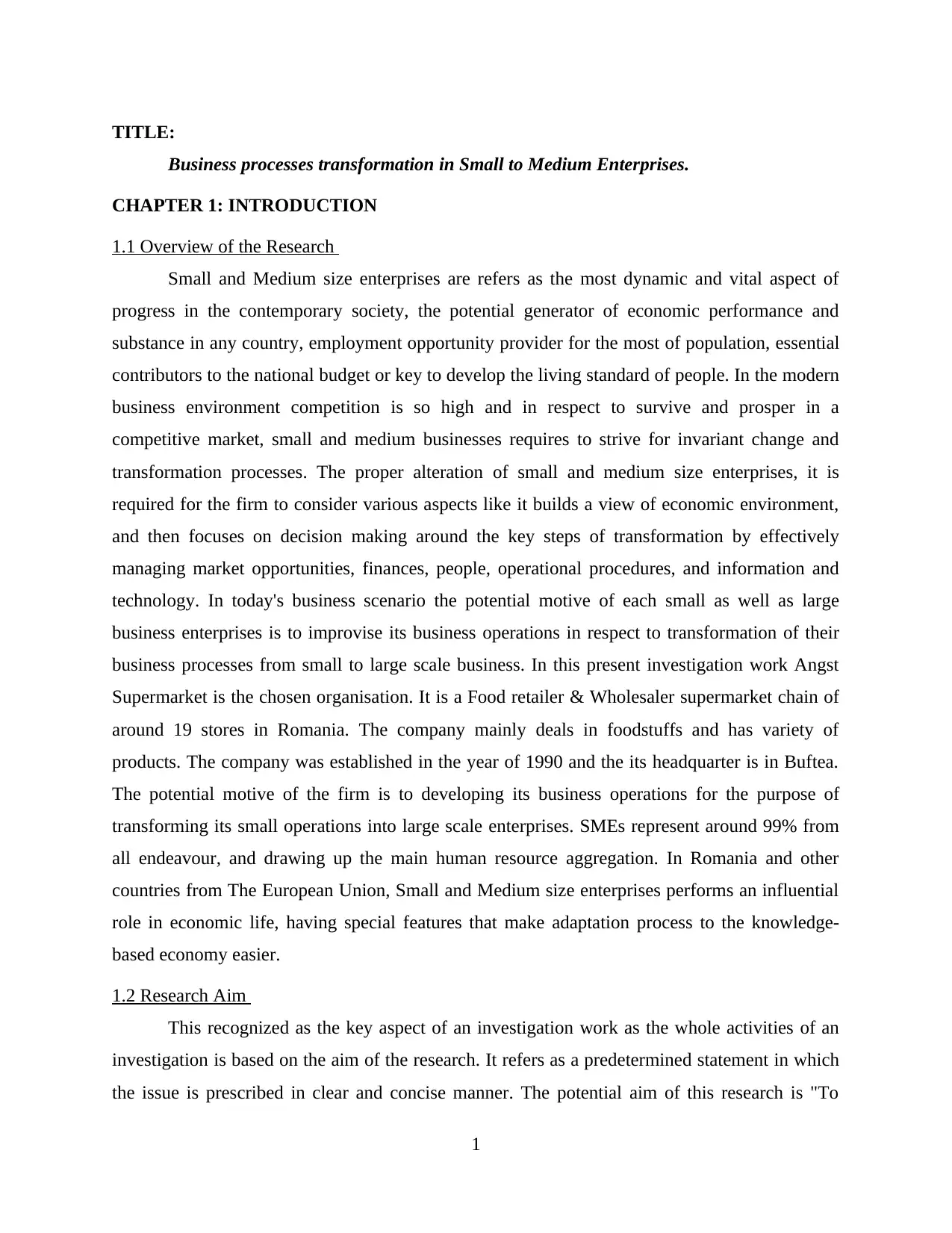
TITLE:
Business processes transformation in Small to Medium Enterprises.
CHAPTER 1: INTRODUCTION
1.1 Overview of the Research
Small and Medium size enterprises are refers as the most dynamic and vital aspect of
progress in the contemporary society, the potential generator of economic performance and
substance in any country, employment opportunity provider for the most of population, essential
contributors to the national budget or key to develop the living standard of people. In the modern
business environment competition is so high and in respect to survive and prosper in a
competitive market, small and medium businesses requires to strive for invariant change and
transformation processes. The proper alteration of small and medium size enterprises, it is
required for the firm to consider various aspects like it builds a view of economic environment,
and then focuses on decision making around the key steps of transformation by effectively
managing market opportunities, finances, people, operational procedures, and information and
technology. In today's business scenario the potential motive of each small as well as large
business enterprises is to improvise its business operations in respect to transformation of their
business processes from small to large scale business. In this present investigation work Angst
Supermarket is the chosen organisation. It is a Food retailer & Wholesaler supermarket chain of
around 19 stores in Romania. The company mainly deals in foodstuffs and has variety of
products. The company was established in the year of 1990 and the its headquarter is in Buftea.
The potential motive of the firm is to developing its business operations for the purpose of
transforming its small operations into large scale enterprises. SMEs represent around 99% from
all endeavour, and drawing up the main human resource aggregation. In Romania and other
countries from The European Union, Small and Medium size enterprises performs an influential
role in economic life, having special features that make adaptation process to the knowledge-
based economy easier.
1.2 Research Aim
This recognized as the key aspect of an investigation work as the whole activities of an
investigation is based on the aim of the research. It refers as a predetermined statement in which
the issue is prescribed in clear and concise manner. The potential aim of this research is "To
1
Business processes transformation in Small to Medium Enterprises.
CHAPTER 1: INTRODUCTION
1.1 Overview of the Research
Small and Medium size enterprises are refers as the most dynamic and vital aspect of
progress in the contemporary society, the potential generator of economic performance and
substance in any country, employment opportunity provider for the most of population, essential
contributors to the national budget or key to develop the living standard of people. In the modern
business environment competition is so high and in respect to survive and prosper in a
competitive market, small and medium businesses requires to strive for invariant change and
transformation processes. The proper alteration of small and medium size enterprises, it is
required for the firm to consider various aspects like it builds a view of economic environment,
and then focuses on decision making around the key steps of transformation by effectively
managing market opportunities, finances, people, operational procedures, and information and
technology. In today's business scenario the potential motive of each small as well as large
business enterprises is to improvise its business operations in respect to transformation of their
business processes from small to large scale business. In this present investigation work Angst
Supermarket is the chosen organisation. It is a Food retailer & Wholesaler supermarket chain of
around 19 stores in Romania. The company mainly deals in foodstuffs and has variety of
products. The company was established in the year of 1990 and the its headquarter is in Buftea.
The potential motive of the firm is to developing its business operations for the purpose of
transforming its small operations into large scale enterprises. SMEs represent around 99% from
all endeavour, and drawing up the main human resource aggregation. In Romania and other
countries from The European Union, Small and Medium size enterprises performs an influential
role in economic life, having special features that make adaptation process to the knowledge-
based economy easier.
1.2 Research Aim
This recognized as the key aspect of an investigation work as the whole activities of an
investigation is based on the aim of the research. It refers as a predetermined statement in which
the issue is prescribed in clear and concise manner. The potential aim of this research is "To
1
⊘ This is a preview!⊘
Do you want full access?
Subscribe today to unlock all pages.

Trusted by 1+ million students worldwide
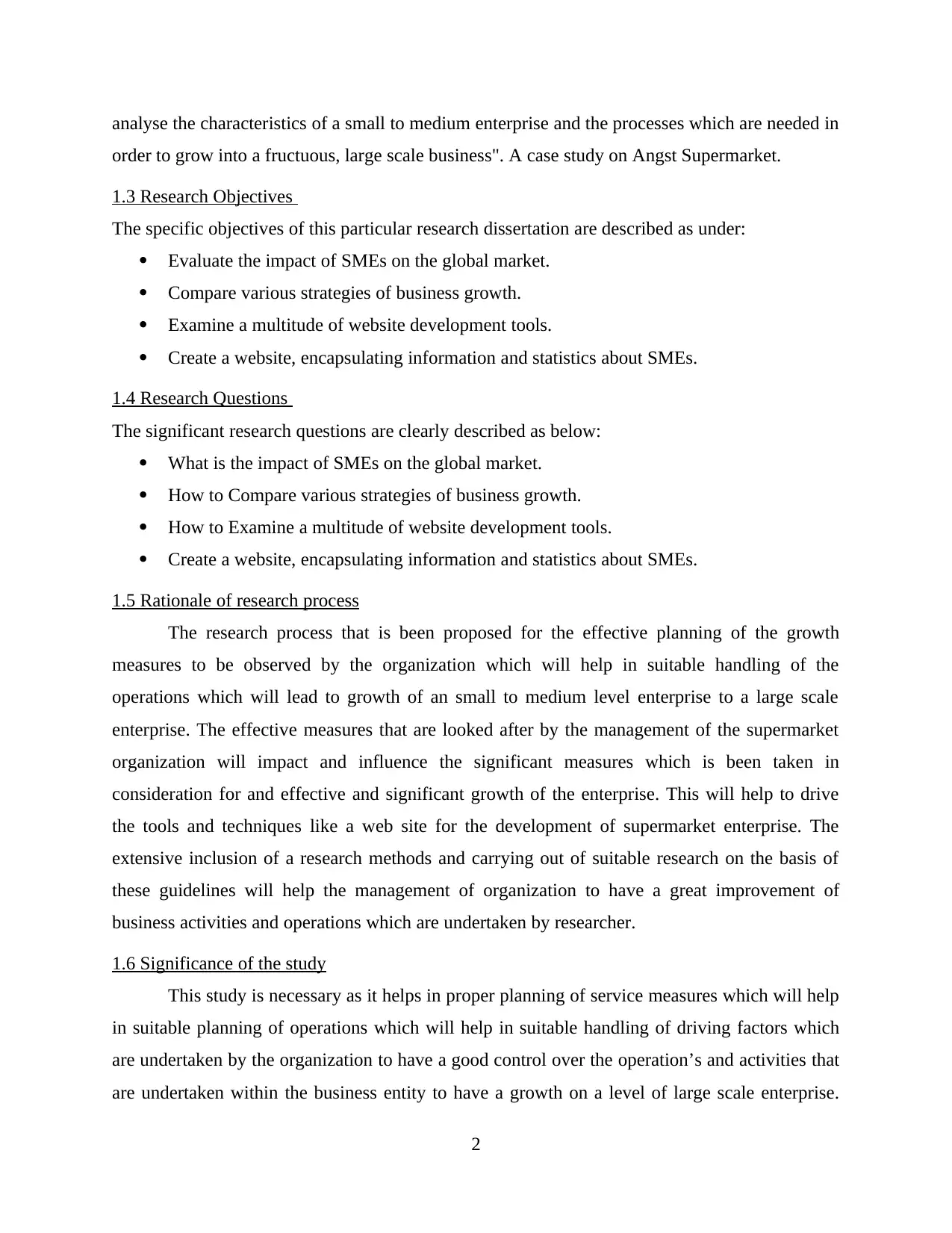
analyse the characteristics of a small to medium enterprise and the processes which are needed in
order to grow into a fructuous, large scale business". A case study on Angst Supermarket.
1.3 Research Objectives
The specific objectives of this particular research dissertation are described as under:
Evaluate the impact of SMEs on the global market.
Compare various strategies of business growth.
Examine a multitude of website development tools.
Create a website, encapsulating information and statistics about SMEs.
1.4 Research Questions
The significant research questions are clearly described as below:
What is the impact of SMEs on the global market.
How to Compare various strategies of business growth.
How to Examine a multitude of website development tools.
Create a website, encapsulating information and statistics about SMEs.
1.5 Rationale of research process
The research process that is been proposed for the effective planning of the growth
measures to be observed by the organization which will help in suitable handling of the
operations which will lead to growth of an small to medium level enterprise to a large scale
enterprise. The effective measures that are looked after by the management of the supermarket
organization will impact and influence the significant measures which is been taken in
consideration for and effective and significant growth of the enterprise. This will help to drive
the tools and techniques like a web site for the development of supermarket enterprise. The
extensive inclusion of a research methods and carrying out of suitable research on the basis of
these guidelines will help the management of organization to have a great improvement of
business activities and operations which are undertaken by researcher.
1.6 Significance of the study
This study is necessary as it helps in proper planning of service measures which will help
in suitable planning of operations which will help in suitable handling of driving factors which
are undertaken by the organization to have a good control over the operation’s and activities that
are undertaken within the business entity to have a growth on a level of large scale enterprise.
2
order to grow into a fructuous, large scale business". A case study on Angst Supermarket.
1.3 Research Objectives
The specific objectives of this particular research dissertation are described as under:
Evaluate the impact of SMEs on the global market.
Compare various strategies of business growth.
Examine a multitude of website development tools.
Create a website, encapsulating information and statistics about SMEs.
1.4 Research Questions
The significant research questions are clearly described as below:
What is the impact of SMEs on the global market.
How to Compare various strategies of business growth.
How to Examine a multitude of website development tools.
Create a website, encapsulating information and statistics about SMEs.
1.5 Rationale of research process
The research process that is been proposed for the effective planning of the growth
measures to be observed by the organization which will help in suitable handling of the
operations which will lead to growth of an small to medium level enterprise to a large scale
enterprise. The effective measures that are looked after by the management of the supermarket
organization will impact and influence the significant measures which is been taken in
consideration for and effective and significant growth of the enterprise. This will help to drive
the tools and techniques like a web site for the development of supermarket enterprise. The
extensive inclusion of a research methods and carrying out of suitable research on the basis of
these guidelines will help the management of organization to have a great improvement of
business activities and operations which are undertaken by researcher.
1.6 Significance of the study
This study is necessary as it helps in proper planning of service measures which will help
in suitable planning of operations which will help in suitable handling of driving factors which
are undertaken by the organization to have a good control over the operation’s and activities that
are undertaken within the business entity to have a growth on a level of large scale enterprise.
2
Paraphrase This Document
Need a fresh take? Get an instant paraphrase of this document with our AI Paraphraser
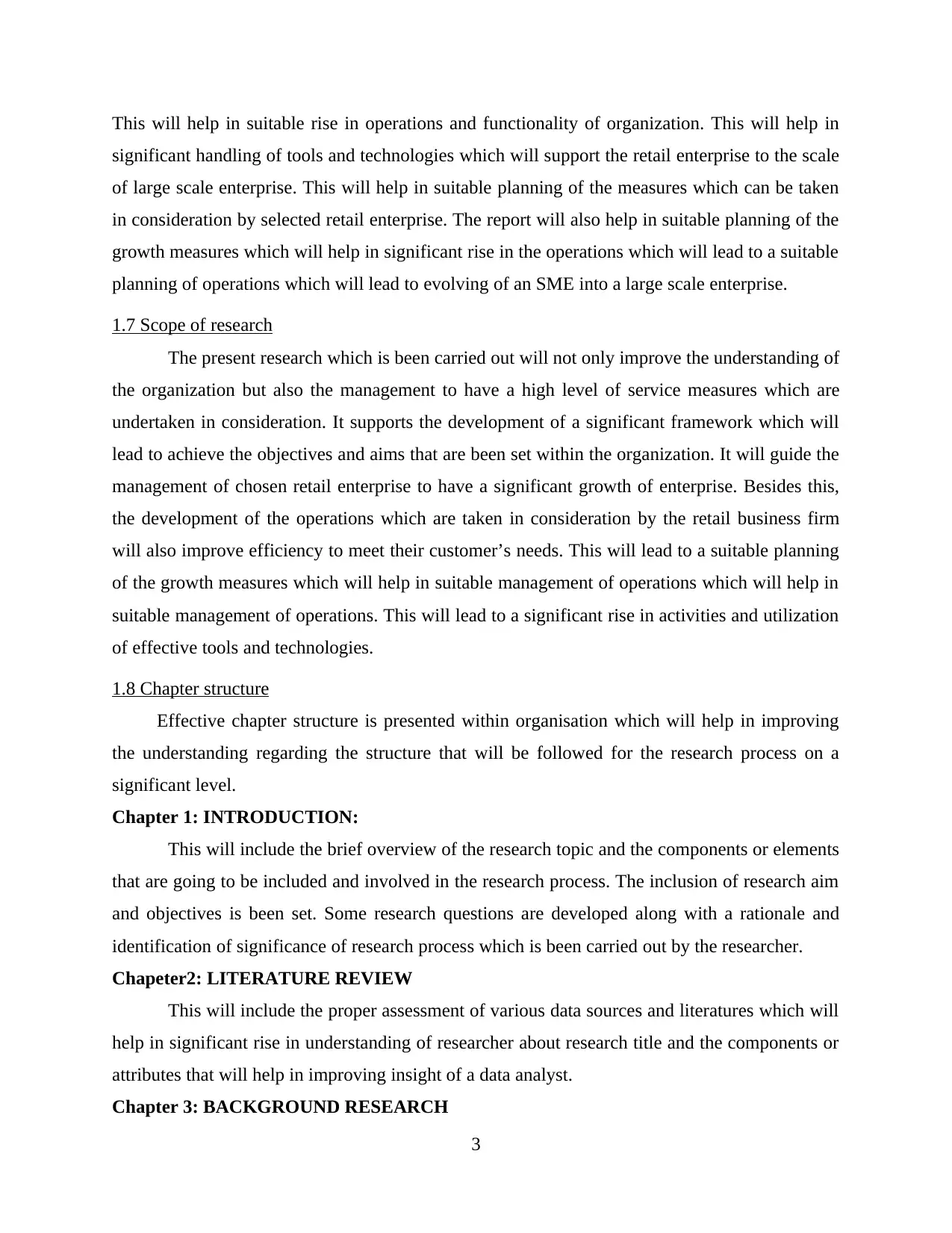
This will help in suitable rise in operations and functionality of organization. This will help in
significant handling of tools and technologies which will support the retail enterprise to the scale
of large scale enterprise. This will help in suitable planning of the measures which can be taken
in consideration by selected retail enterprise. The report will also help in suitable planning of the
growth measures which will help in significant rise in the operations which will lead to a suitable
planning of operations which will lead to evolving of an SME into a large scale enterprise.
1.7 Scope of research
The present research which is been carried out will not only improve the understanding of
the organization but also the management to have a high level of service measures which are
undertaken in consideration. It supports the development of a significant framework which will
lead to achieve the objectives and aims that are been set within the organization. It will guide the
management of chosen retail enterprise to have a significant growth of enterprise. Besides this,
the development of the operations which are taken in consideration by the retail business firm
will also improve efficiency to meet their customer’s needs. This will lead to a suitable planning
of the growth measures which will help in suitable management of operations which will help in
suitable management of operations. This will lead to a significant rise in activities and utilization
of effective tools and technologies.
1.8 Chapter structure
Effective chapter structure is presented within organisation which will help in improving
the understanding regarding the structure that will be followed for the research process on a
significant level.
Chapter 1: INTRODUCTION:
This will include the brief overview of the research topic and the components or elements
that are going to be included and involved in the research process. The inclusion of research aim
and objectives is been set. Some research questions are developed along with a rationale and
identification of significance of research process which is been carried out by the researcher.
Chapeter2: LITERATURE REVIEW
This will include the proper assessment of various data sources and literatures which will
help in significant rise in understanding of researcher about research title and the components or
attributes that will help in improving insight of a data analyst.
Chapter 3: BACKGROUND RESEARCH
3
significant handling of tools and technologies which will support the retail enterprise to the scale
of large scale enterprise. This will help in suitable planning of the measures which can be taken
in consideration by selected retail enterprise. The report will also help in suitable planning of the
growth measures which will help in significant rise in the operations which will lead to a suitable
planning of operations which will lead to evolving of an SME into a large scale enterprise.
1.7 Scope of research
The present research which is been carried out will not only improve the understanding of
the organization but also the management to have a high level of service measures which are
undertaken in consideration. It supports the development of a significant framework which will
lead to achieve the objectives and aims that are been set within the organization. It will guide the
management of chosen retail enterprise to have a significant growth of enterprise. Besides this,
the development of the operations which are taken in consideration by the retail business firm
will also improve efficiency to meet their customer’s needs. This will lead to a suitable planning
of the growth measures which will help in suitable management of operations which will help in
suitable management of operations. This will lead to a significant rise in activities and utilization
of effective tools and technologies.
1.8 Chapter structure
Effective chapter structure is presented within organisation which will help in improving
the understanding regarding the structure that will be followed for the research process on a
significant level.
Chapter 1: INTRODUCTION:
This will include the brief overview of the research topic and the components or elements
that are going to be included and involved in the research process. The inclusion of research aim
and objectives is been set. Some research questions are developed along with a rationale and
identification of significance of research process which is been carried out by the researcher.
Chapeter2: LITERATURE REVIEW
This will include the proper assessment of various data sources and literatures which will
help in significant rise in understanding of researcher about research title and the components or
attributes that will help in improving insight of a data analyst.
Chapter 3: BACKGROUND RESEARCH
3
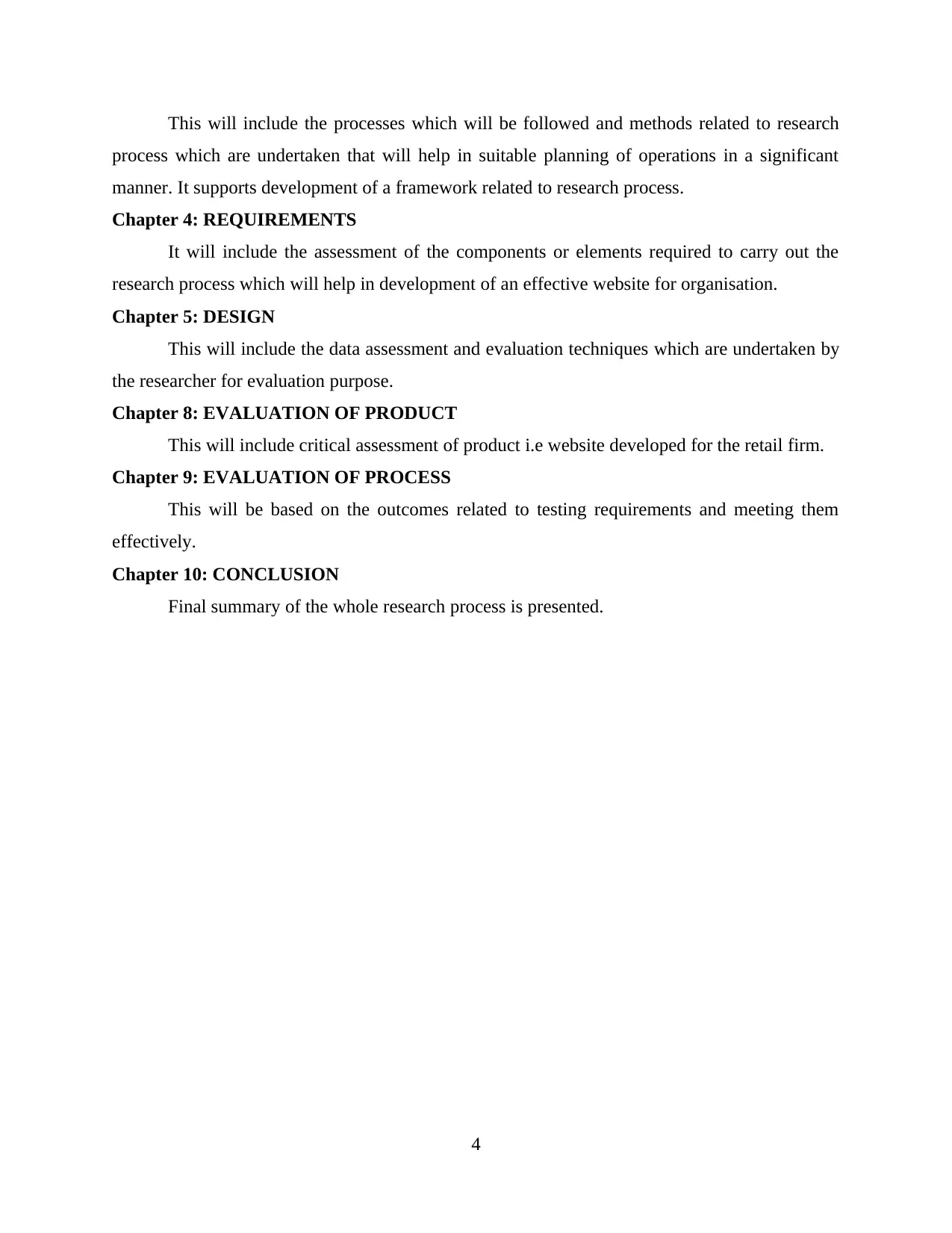
This will include the processes which will be followed and methods related to research
process which are undertaken that will help in suitable planning of operations in a significant
manner. It supports development of a framework related to research process.
Chapter 4: REQUIREMENTS
It will include the assessment of the components or elements required to carry out the
research process which will help in development of an effective website for organisation.
Chapter 5: DESIGN
This will include the data assessment and evaluation techniques which are undertaken by
the researcher for evaluation purpose.
Chapter 8: EVALUATION OF PRODUCT
This will include critical assessment of product i.e website developed for the retail firm.
Chapter 9: EVALUATION OF PROCESS
This will be based on the outcomes related to testing requirements and meeting them
effectively.
Chapter 10: CONCLUSION
Final summary of the whole research process is presented.
4
process which are undertaken that will help in suitable planning of operations in a significant
manner. It supports development of a framework related to research process.
Chapter 4: REQUIREMENTS
It will include the assessment of the components or elements required to carry out the
research process which will help in development of an effective website for organisation.
Chapter 5: DESIGN
This will include the data assessment and evaluation techniques which are undertaken by
the researcher for evaluation purpose.
Chapter 8: EVALUATION OF PRODUCT
This will include critical assessment of product i.e website developed for the retail firm.
Chapter 9: EVALUATION OF PROCESS
This will be based on the outcomes related to testing requirements and meeting them
effectively.
Chapter 10: CONCLUSION
Final summary of the whole research process is presented.
4
⊘ This is a preview!⊘
Do you want full access?
Subscribe today to unlock all pages.

Trusted by 1+ million students worldwide
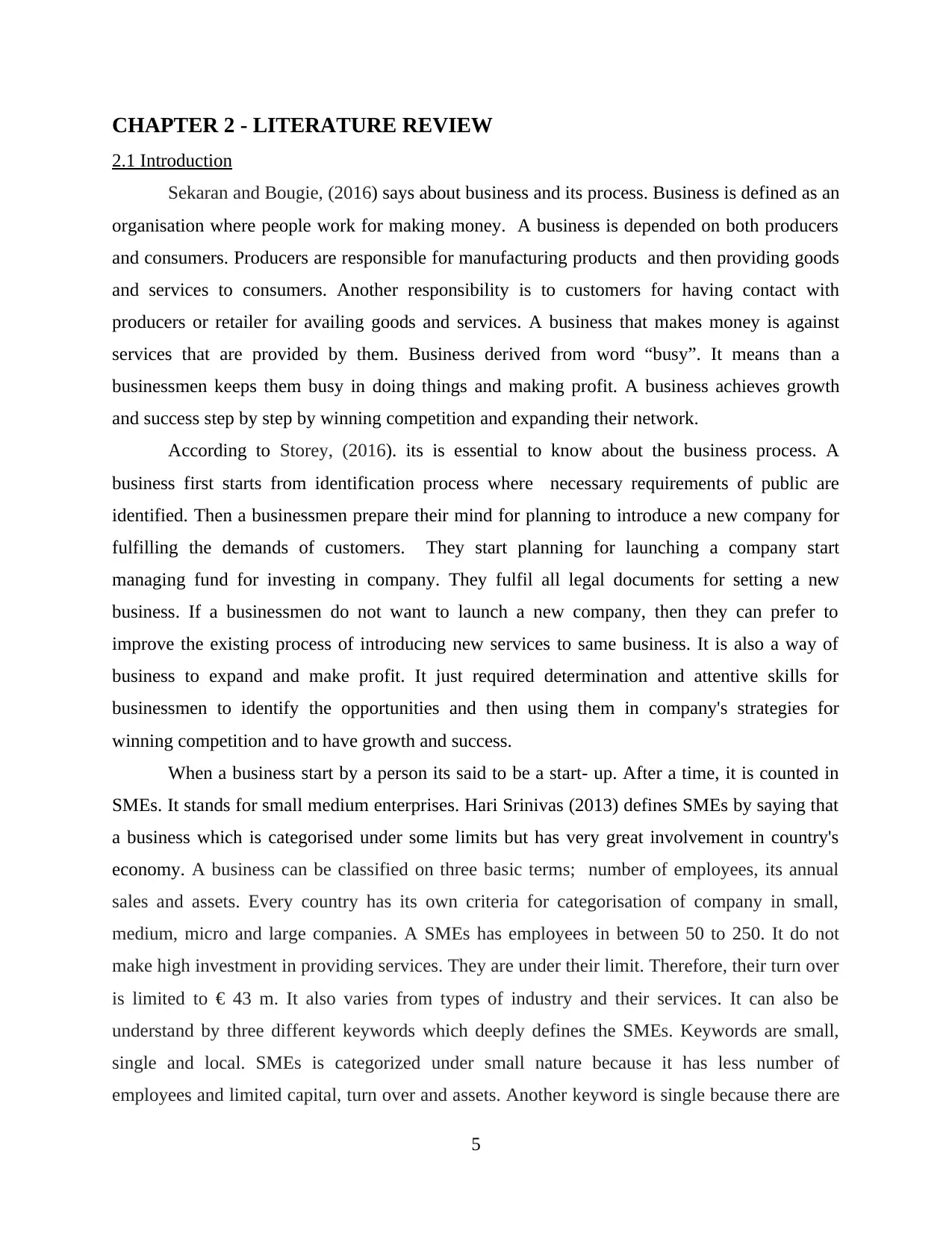
CHAPTER 2 - LITERATURE REVIEW
2.1 Introduction
Sekaran and Bougie, (2016) says about business and its process. Business is defined as an
organisation where people work for making money. A business is depended on both producers
and consumers. Producers are responsible for manufacturing products and then providing goods
and services to consumers. Another responsibility is to customers for having contact with
producers or retailer for availing goods and services. A business that makes money is against
services that are provided by them. Business derived from word “busy”. It means than a
businessmen keeps them busy in doing things and making profit. A business achieves growth
and success step by step by winning competition and expanding their network.
According to Storey, (2016). its is essential to know about the business process. A
business first starts from identification process where necessary requirements of public are
identified. Then a businessmen prepare their mind for planning to introduce a new company for
fulfilling the demands of customers. They start planning for launching a company start
managing fund for investing in company. They fulfil all legal documents for setting a new
business. If a businessmen do not want to launch a new company, then they can prefer to
improve the existing process of introducing new services to same business. It is also a way of
business to expand and make profit. It just required determination and attentive skills for
businessmen to identify the opportunities and then using them in company's strategies for
winning competition and to have growth and success.
When a business start by a person its said to be a start- up. After a time, it is counted in
SMEs. It stands for small medium enterprises. Hari Srinivas (2013) defines SMEs by saying that
a business which is categorised under some limits but has very great involvement in country's
economy. A business can be classified on three basic terms; number of employees, its annual
sales and assets. Every country has its own criteria for categorisation of company in small,
medium, micro and large companies. A SMEs has employees in between 50 to 250. It do not
make high investment in providing services. They are under their limit. Therefore, their turn over
is limited to € 43 m. It also varies from types of industry and their services. It can also be
understand by three different keywords which deeply defines the SMEs. Keywords are small,
single and local. SMEs is categorized under small nature because it has less number of
employees and limited capital, turn over and assets. Another keyword is single because there are
5
2.1 Introduction
Sekaran and Bougie, (2016) says about business and its process. Business is defined as an
organisation where people work for making money. A business is depended on both producers
and consumers. Producers are responsible for manufacturing products and then providing goods
and services to consumers. Another responsibility is to customers for having contact with
producers or retailer for availing goods and services. A business that makes money is against
services that are provided by them. Business derived from word “busy”. It means than a
businessmen keeps them busy in doing things and making profit. A business achieves growth
and success step by step by winning competition and expanding their network.
According to Storey, (2016). its is essential to know about the business process. A
business first starts from identification process where necessary requirements of public are
identified. Then a businessmen prepare their mind for planning to introduce a new company for
fulfilling the demands of customers. They start planning for launching a company start
managing fund for investing in company. They fulfil all legal documents for setting a new
business. If a businessmen do not want to launch a new company, then they can prefer to
improve the existing process of introducing new services to same business. It is also a way of
business to expand and make profit. It just required determination and attentive skills for
businessmen to identify the opportunities and then using them in company's strategies for
winning competition and to have growth and success.
When a business start by a person its said to be a start- up. After a time, it is counted in
SMEs. It stands for small medium enterprises. Hari Srinivas (2013) defines SMEs by saying that
a business which is categorised under some limits but has very great involvement in country's
economy. A business can be classified on three basic terms; number of employees, its annual
sales and assets. Every country has its own criteria for categorisation of company in small,
medium, micro and large companies. A SMEs has employees in between 50 to 250. It do not
make high investment in providing services. They are under their limit. Therefore, their turn over
is limited to € 43 m. It also varies from types of industry and their services. It can also be
understand by three different keywords which deeply defines the SMEs. Keywords are small,
single and local. SMEs is categorized under small nature because it has less number of
employees and limited capital, turn over and assets. Another keyword is single because there are
5
Paraphrase This Document
Need a fresh take? Get an instant paraphrase of this document with our AI Paraphraser
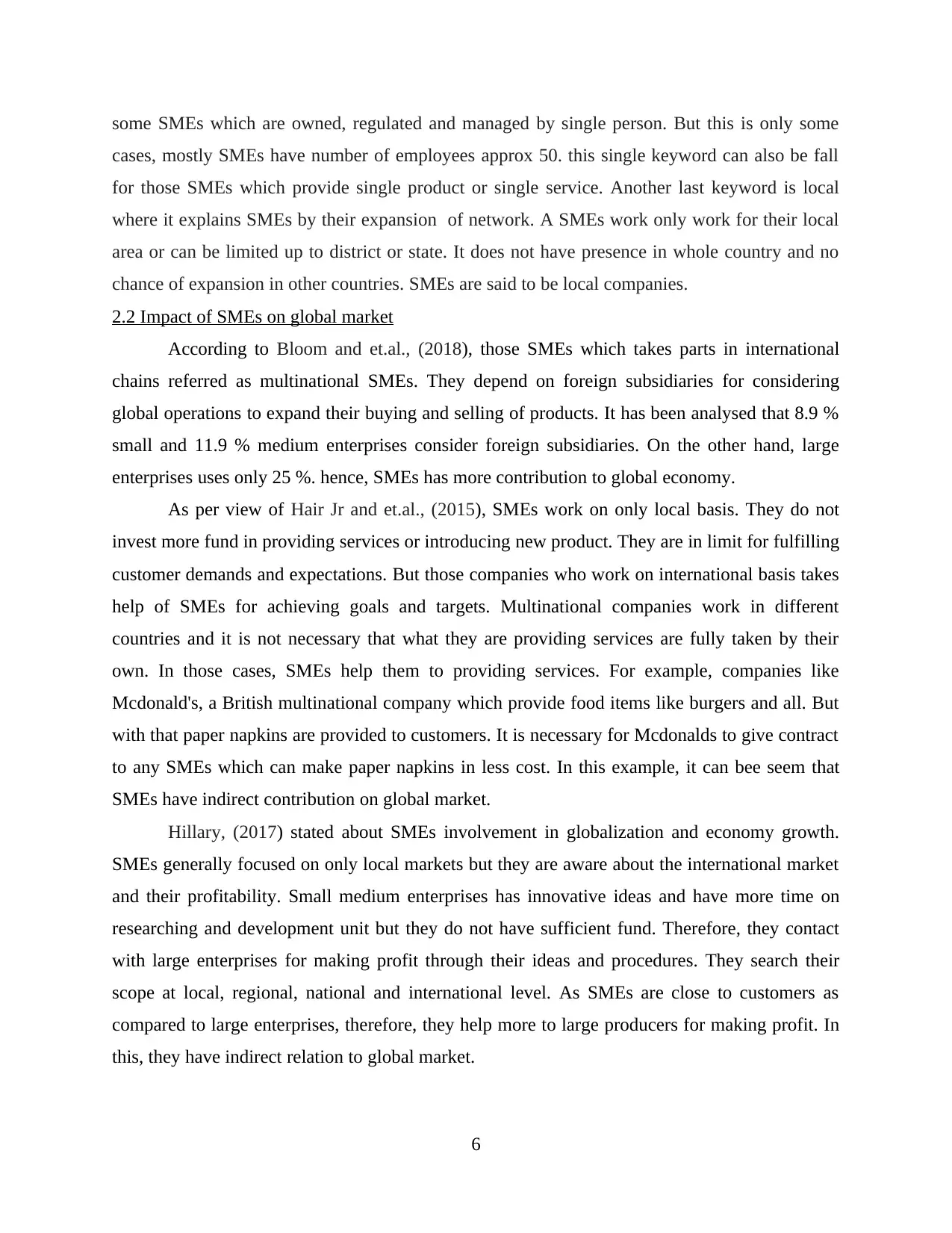
some SMEs which are owned, regulated and managed by single person. But this is only some
cases, mostly SMEs have number of employees approx 50. this single keyword can also be fall
for those SMEs which provide single product or single service. Another last keyword is local
where it explains SMEs by their expansion of network. A SMEs work only work for their local
area or can be limited up to district or state. It does not have presence in whole country and no
chance of expansion in other countries. SMEs are said to be local companies.
2.2 Impact of SMEs on global market
According to Bloom and et.al., (2018), those SMEs which takes parts in international
chains referred as multinational SMEs. They depend on foreign subsidiaries for considering
global operations to expand their buying and selling of products. It has been analysed that 8.9 %
small and 11.9 % medium enterprises consider foreign subsidiaries. On the other hand, large
enterprises uses only 25 %. hence, SMEs has more contribution to global economy.
As per view of Hair Jr and et.al., (2015), SMEs work on only local basis. They do not
invest more fund in providing services or introducing new product. They are in limit for fulfilling
customer demands and expectations. But those companies who work on international basis takes
help of SMEs for achieving goals and targets. Multinational companies work in different
countries and it is not necessary that what they are providing services are fully taken by their
own. In those cases, SMEs help them to providing services. For example, companies like
Mcdonald's, a British multinational company which provide food items like burgers and all. But
with that paper napkins are provided to customers. It is necessary for Mcdonalds to give contract
to any SMEs which can make paper napkins in less cost. In this example, it can bee seem that
SMEs have indirect contribution on global market.
Hillary, (2017) stated about SMEs involvement in globalization and economy growth.
SMEs generally focused on only local markets but they are aware about the international market
and their profitability. Small medium enterprises has innovative ideas and have more time on
researching and development unit but they do not have sufficient fund. Therefore, they contact
with large enterprises for making profit through their ideas and procedures. They search their
scope at local, regional, national and international level. As SMEs are close to customers as
compared to large enterprises, therefore, they help more to large producers for making profit. In
this, they have indirect relation to global market.
6
cases, mostly SMEs have number of employees approx 50. this single keyword can also be fall
for those SMEs which provide single product or single service. Another last keyword is local
where it explains SMEs by their expansion of network. A SMEs work only work for their local
area or can be limited up to district or state. It does not have presence in whole country and no
chance of expansion in other countries. SMEs are said to be local companies.
2.2 Impact of SMEs on global market
According to Bloom and et.al., (2018), those SMEs which takes parts in international
chains referred as multinational SMEs. They depend on foreign subsidiaries for considering
global operations to expand their buying and selling of products. It has been analysed that 8.9 %
small and 11.9 % medium enterprises consider foreign subsidiaries. On the other hand, large
enterprises uses only 25 %. hence, SMEs has more contribution to global economy.
As per view of Hair Jr and et.al., (2015), SMEs work on only local basis. They do not
invest more fund in providing services or introducing new product. They are in limit for fulfilling
customer demands and expectations. But those companies who work on international basis takes
help of SMEs for achieving goals and targets. Multinational companies work in different
countries and it is not necessary that what they are providing services are fully taken by their
own. In those cases, SMEs help them to providing services. For example, companies like
Mcdonald's, a British multinational company which provide food items like burgers and all. But
with that paper napkins are provided to customers. It is necessary for Mcdonalds to give contract
to any SMEs which can make paper napkins in less cost. In this example, it can bee seem that
SMEs have indirect contribution on global market.
Hillary, (2017) stated about SMEs involvement in globalization and economy growth.
SMEs generally focused on only local markets but they are aware about the international market
and their profitability. Small medium enterprises has innovative ideas and have more time on
researching and development unit but they do not have sufficient fund. Therefore, they contact
with large enterprises for making profit through their ideas and procedures. They search their
scope at local, regional, national and international level. As SMEs are close to customers as
compared to large enterprises, therefore, they help more to large producers for making profit. In
this, they have indirect relation to global market.
6
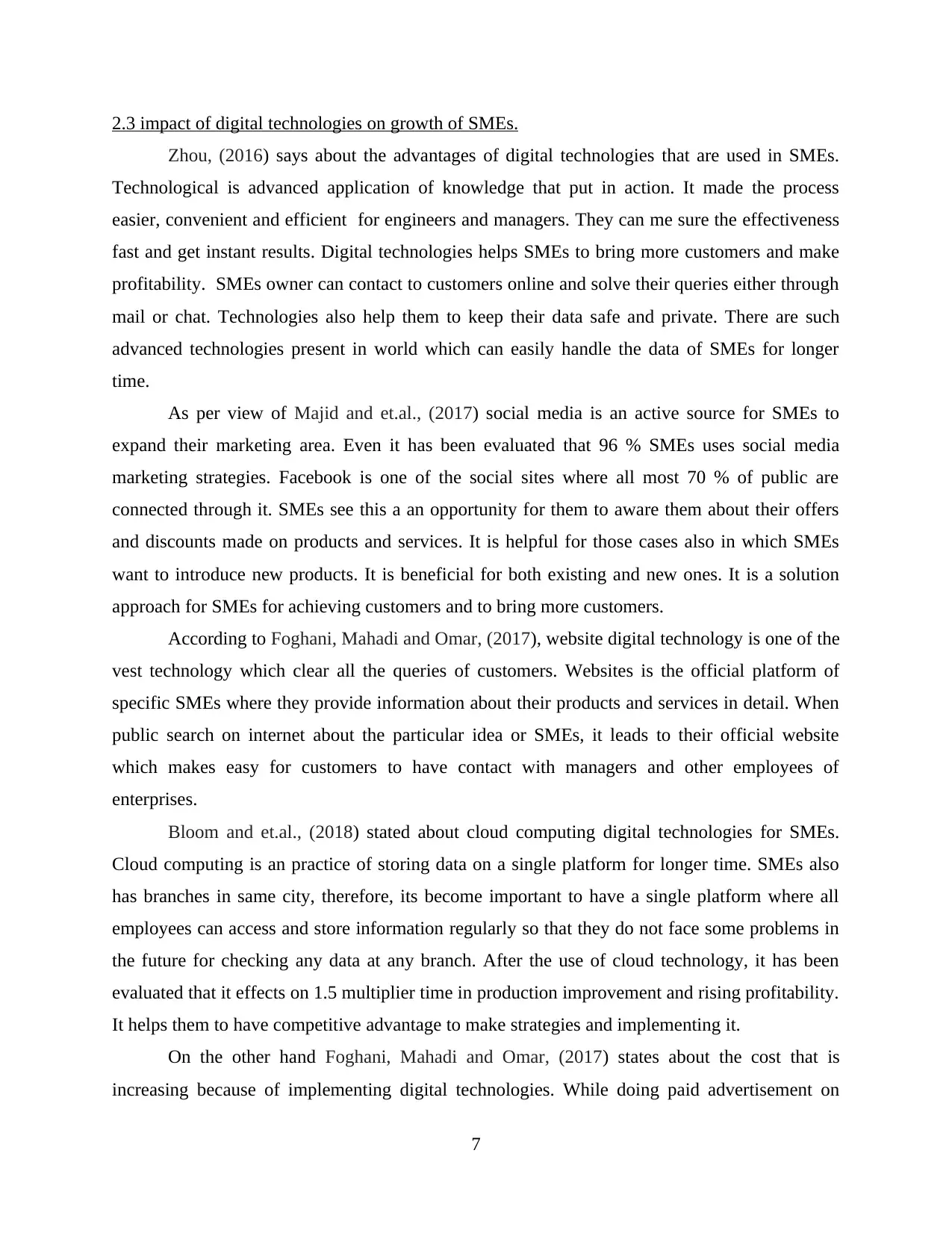
2.3 impact of digital technologies on growth of SMEs.
Zhou, (2016) says about the advantages of digital technologies that are used in SMEs.
Technological is advanced application of knowledge that put in action. It made the process
easier, convenient and efficient for engineers and managers. They can me sure the effectiveness
fast and get instant results. Digital technologies helps SMEs to bring more customers and make
profitability. SMEs owner can contact to customers online and solve their queries either through
mail or chat. Technologies also help them to keep their data safe and private. There are such
advanced technologies present in world which can easily handle the data of SMEs for longer
time.
As per view of Majid and et.al., (2017) social media is an active source for SMEs to
expand their marketing area. Even it has been evaluated that 96 % SMEs uses social media
marketing strategies. Facebook is one of the social sites where all most 70 % of public are
connected through it. SMEs see this a an opportunity for them to aware them about their offers
and discounts made on products and services. It is helpful for those cases also in which SMEs
want to introduce new products. It is beneficial for both existing and new ones. It is a solution
approach for SMEs for achieving customers and to bring more customers.
According to Foghani, Mahadi and Omar, (2017), website digital technology is one of the
vest technology which clear all the queries of customers. Websites is the official platform of
specific SMEs where they provide information about their products and services in detail. When
public search on internet about the particular idea or SMEs, it leads to their official website
which makes easy for customers to have contact with managers and other employees of
enterprises.
Bloom and et.al., (2018) stated about cloud computing digital technologies for SMEs.
Cloud computing is an practice of storing data on a single platform for longer time. SMEs also
has branches in same city, therefore, its become important to have a single platform where all
employees can access and store information regularly so that they do not face some problems in
the future for checking any data at any branch. After the use of cloud technology, it has been
evaluated that it effects on 1.5 multiplier time in production improvement and rising profitability.
It helps them to have competitive advantage to make strategies and implementing it.
On the other hand Foghani, Mahadi and Omar, (2017) states about the cost that is
increasing because of implementing digital technologies. While doing paid advertisement on
7
Zhou, (2016) says about the advantages of digital technologies that are used in SMEs.
Technological is advanced application of knowledge that put in action. It made the process
easier, convenient and efficient for engineers and managers. They can me sure the effectiveness
fast and get instant results. Digital technologies helps SMEs to bring more customers and make
profitability. SMEs owner can contact to customers online and solve their queries either through
mail or chat. Technologies also help them to keep their data safe and private. There are such
advanced technologies present in world which can easily handle the data of SMEs for longer
time.
As per view of Majid and et.al., (2017) social media is an active source for SMEs to
expand their marketing area. Even it has been evaluated that 96 % SMEs uses social media
marketing strategies. Facebook is one of the social sites where all most 70 % of public are
connected through it. SMEs see this a an opportunity for them to aware them about their offers
and discounts made on products and services. It is helpful for those cases also in which SMEs
want to introduce new products. It is beneficial for both existing and new ones. It is a solution
approach for SMEs for achieving customers and to bring more customers.
According to Foghani, Mahadi and Omar, (2017), website digital technology is one of the
vest technology which clear all the queries of customers. Websites is the official platform of
specific SMEs where they provide information about their products and services in detail. When
public search on internet about the particular idea or SMEs, it leads to their official website
which makes easy for customers to have contact with managers and other employees of
enterprises.
Bloom and et.al., (2018) stated about cloud computing digital technologies for SMEs.
Cloud computing is an practice of storing data on a single platform for longer time. SMEs also
has branches in same city, therefore, its become important to have a single platform where all
employees can access and store information regularly so that they do not face some problems in
the future for checking any data at any branch. After the use of cloud technology, it has been
evaluated that it effects on 1.5 multiplier time in production improvement and rising profitability.
It helps them to have competitive advantage to make strategies and implementing it.
On the other hand Foghani, Mahadi and Omar, (2017) states about the cost that is
increasing because of implementing digital technologies. While doing paid advertisement on
7
⊘ This is a preview!⊘
Do you want full access?
Subscribe today to unlock all pages.

Trusted by 1+ million students worldwide
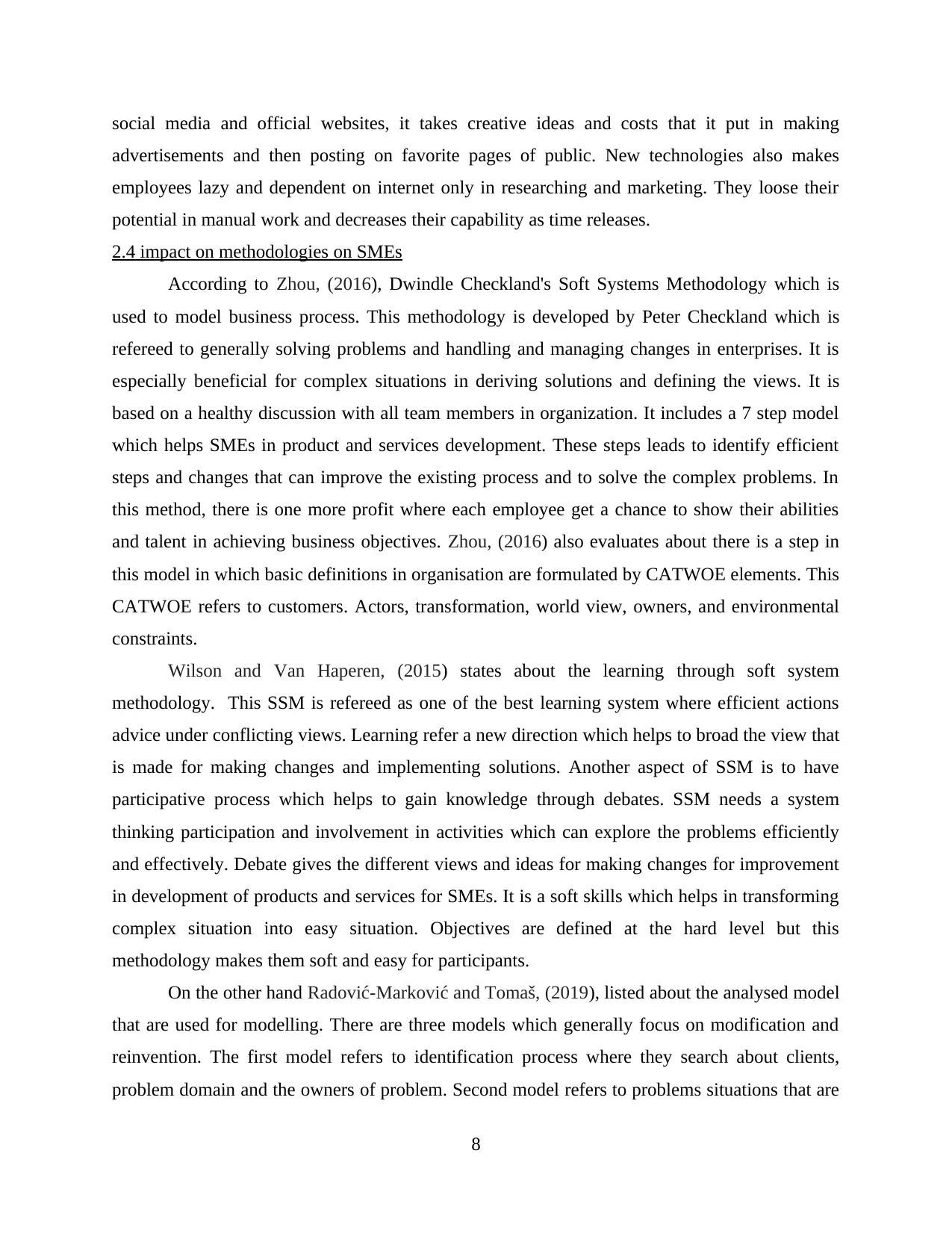
social media and official websites, it takes creative ideas and costs that it put in making
advertisements and then posting on favorite pages of public. New technologies also makes
employees lazy and dependent on internet only in researching and marketing. They loose their
potential in manual work and decreases their capability as time releases.
2.4 impact on methodologies on SMEs
According to Zhou, (2016), Dwindle Checkland's Soft Systems Methodology which is
used to model business process. This methodology is developed by Peter Checkland which is
refereed to generally solving problems and handling and managing changes in enterprises. It is
especially beneficial for complex situations in deriving solutions and defining the views. It is
based on a healthy discussion with all team members in organization. It includes a 7 step model
which helps SMEs in product and services development. These steps leads to identify efficient
steps and changes that can improve the existing process and to solve the complex problems. In
this method, there is one more profit where each employee get a chance to show their abilities
and talent in achieving business objectives. Zhou, (2016) also evaluates about there is a step in
this model in which basic definitions in organisation are formulated by CATWOE elements. This
CATWOE refers to customers. Actors, transformation, world view, owners, and environmental
constraints.
Wilson and Van Haperen, (2015) states about the learning through soft system
methodology. This SSM is refereed as one of the best learning system where efficient actions
advice under conflicting views. Learning refer a new direction which helps to broad the view that
is made for making changes and implementing solutions. Another aspect of SSM is to have
participative process which helps to gain knowledge through debates. SSM needs a system
thinking participation and involvement in activities which can explore the problems efficiently
and effectively. Debate gives the different views and ideas for making changes for improvement
in development of products and services for SMEs. It is a soft skills which helps in transforming
complex situation into easy situation. Objectives are defined at the hard level but this
methodology makes them soft and easy for participants.
On the other hand Radović-Marković and Tomaš, (2019), listed about the analysed model
that are used for modelling. There are three models which generally focus on modification and
reinvention. The first model refers to identification process where they search about clients,
problem domain and the owners of problem. Second model refers to problems situations that are
8
advertisements and then posting on favorite pages of public. New technologies also makes
employees lazy and dependent on internet only in researching and marketing. They loose their
potential in manual work and decreases their capability as time releases.
2.4 impact on methodologies on SMEs
According to Zhou, (2016), Dwindle Checkland's Soft Systems Methodology which is
used to model business process. This methodology is developed by Peter Checkland which is
refereed to generally solving problems and handling and managing changes in enterprises. It is
especially beneficial for complex situations in deriving solutions and defining the views. It is
based on a healthy discussion with all team members in organization. It includes a 7 step model
which helps SMEs in product and services development. These steps leads to identify efficient
steps and changes that can improve the existing process and to solve the complex problems. In
this method, there is one more profit where each employee get a chance to show their abilities
and talent in achieving business objectives. Zhou, (2016) also evaluates about there is a step in
this model in which basic definitions in organisation are formulated by CATWOE elements. This
CATWOE refers to customers. Actors, transformation, world view, owners, and environmental
constraints.
Wilson and Van Haperen, (2015) states about the learning through soft system
methodology. This SSM is refereed as one of the best learning system where efficient actions
advice under conflicting views. Learning refer a new direction which helps to broad the view that
is made for making changes and implementing solutions. Another aspect of SSM is to have
participative process which helps to gain knowledge through debates. SSM needs a system
thinking participation and involvement in activities which can explore the problems efficiently
and effectively. Debate gives the different views and ideas for making changes for improvement
in development of products and services for SMEs. It is a soft skills which helps in transforming
complex situation into easy situation. Objectives are defined at the hard level but this
methodology makes them soft and easy for participants.
On the other hand Radović-Marković and Tomaš, (2019), listed about the analysed model
that are used for modelling. There are three models which generally focus on modification and
reinvention. The first model refers to identification process where they search about clients,
problem domain and the owners of problem. Second model refers to problems situations that are
8
Paraphrase This Document
Need a fresh take? Get an instant paraphrase of this document with our AI Paraphraser
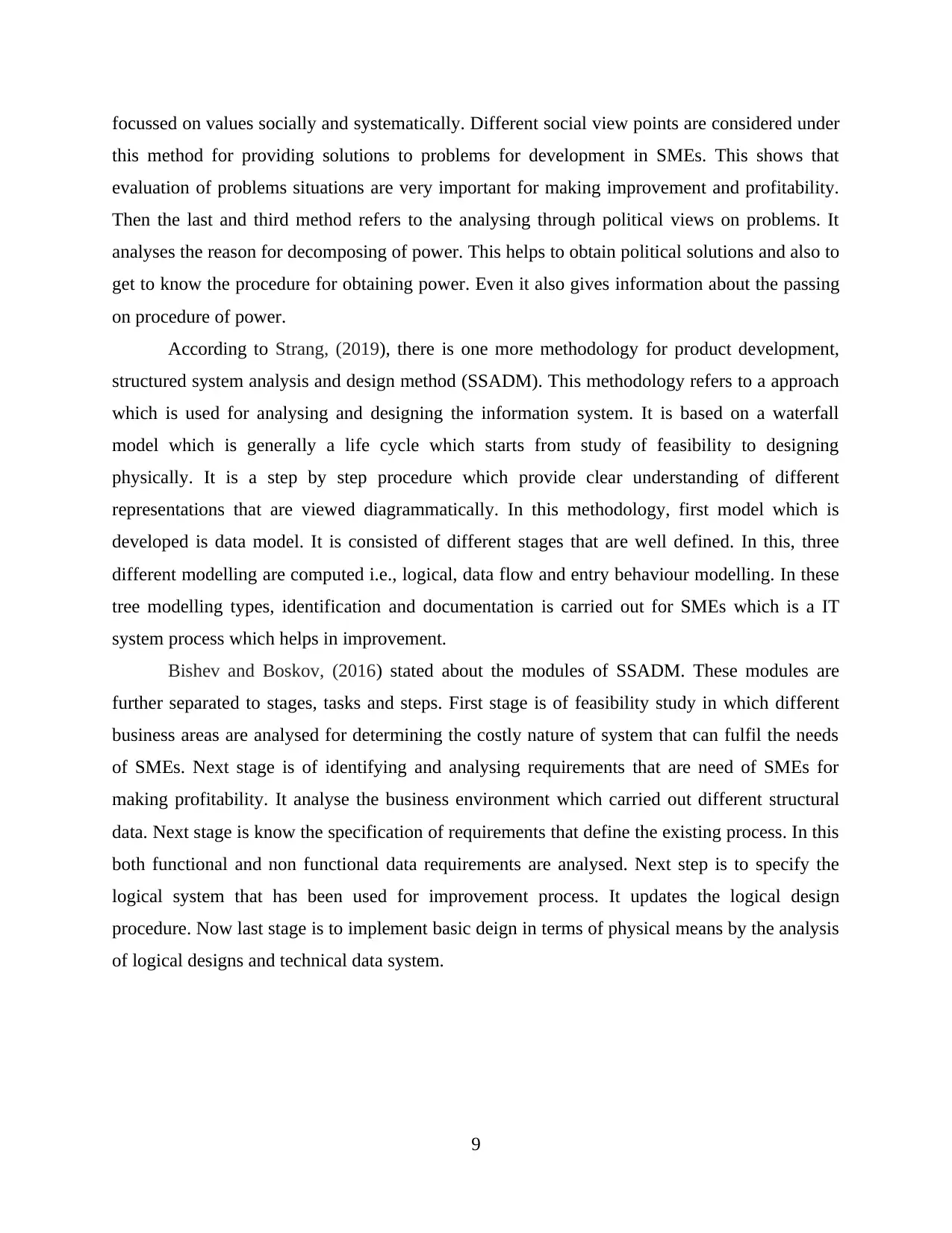
focussed on values socially and systematically. Different social view points are considered under
this method for providing solutions to problems for development in SMEs. This shows that
evaluation of problems situations are very important for making improvement and profitability.
Then the last and third method refers to the analysing through political views on problems. It
analyses the reason for decomposing of power. This helps to obtain political solutions and also to
get to know the procedure for obtaining power. Even it also gives information about the passing
on procedure of power.
According to Strang, (2019), there is one more methodology for product development,
structured system analysis and design method (SSADM). This methodology refers to a approach
which is used for analysing and designing the information system. It is based on a waterfall
model which is generally a life cycle which starts from study of feasibility to designing
physically. It is a step by step procedure which provide clear understanding of different
representations that are viewed diagrammatically. In this methodology, first model which is
developed is data model. It is consisted of different stages that are well defined. In this, three
different modelling are computed i.e., logical, data flow and entry behaviour modelling. In these
tree modelling types, identification and documentation is carried out for SMEs which is a IT
system process which helps in improvement.
Bishev and Boskov, (2016) stated about the modules of SSADM. These modules are
further separated to stages, tasks and steps. First stage is of feasibility study in which different
business areas are analysed for determining the costly nature of system that can fulfil the needs
of SMEs. Next stage is of identifying and analysing requirements that are need of SMEs for
making profitability. It analyse the business environment which carried out different structural
data. Next stage is know the specification of requirements that define the existing process. In this
both functional and non functional data requirements are analysed. Next step is to specify the
logical system that has been used for improvement process. It updates the logical design
procedure. Now last stage is to implement basic deign in terms of physical means by the analysis
of logical designs and technical data system.
9
this method for providing solutions to problems for development in SMEs. This shows that
evaluation of problems situations are very important for making improvement and profitability.
Then the last and third method refers to the analysing through political views on problems. It
analyses the reason for decomposing of power. This helps to obtain political solutions and also to
get to know the procedure for obtaining power. Even it also gives information about the passing
on procedure of power.
According to Strang, (2019), there is one more methodology for product development,
structured system analysis and design method (SSADM). This methodology refers to a approach
which is used for analysing and designing the information system. It is based on a waterfall
model which is generally a life cycle which starts from study of feasibility to designing
physically. It is a step by step procedure which provide clear understanding of different
representations that are viewed diagrammatically. In this methodology, first model which is
developed is data model. It is consisted of different stages that are well defined. In this, three
different modelling are computed i.e., logical, data flow and entry behaviour modelling. In these
tree modelling types, identification and documentation is carried out for SMEs which is a IT
system process which helps in improvement.
Bishev and Boskov, (2016) stated about the modules of SSADM. These modules are
further separated to stages, tasks and steps. First stage is of feasibility study in which different
business areas are analysed for determining the costly nature of system that can fulfil the needs
of SMEs. Next stage is of identifying and analysing requirements that are need of SMEs for
making profitability. It analyse the business environment which carried out different structural
data. Next stage is know the specification of requirements that define the existing process. In this
both functional and non functional data requirements are analysed. Next step is to specify the
logical system that has been used for improvement process. It updates the logical design
procedure. Now last stage is to implement basic deign in terms of physical means by the analysis
of logical designs and technical data system.
9
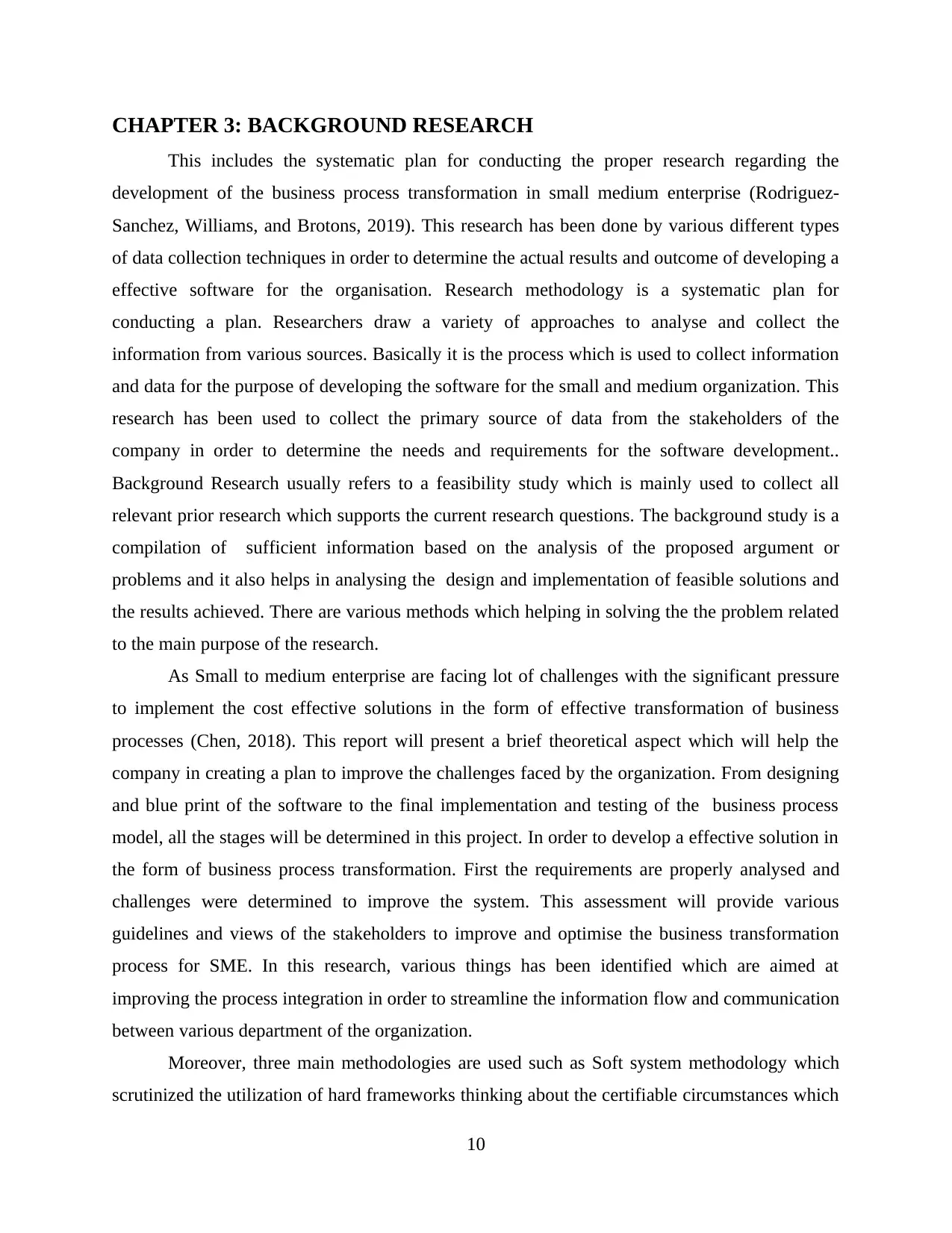
CHAPTER 3: BACKGROUND RESEARCH
This includes the systematic plan for conducting the proper research regarding the
development of the business process transformation in small medium enterprise (Rodriguez-
Sanchez, Williams, and Brotons, 2019). This research has been done by various different types
of data collection techniques in order to determine the actual results and outcome of developing a
effective software for the organisation. Research methodology is a systematic plan for
conducting a plan. Researchers draw a variety of approaches to analyse and collect the
information from various sources. Basically it is the process which is used to collect information
and data for the purpose of developing the software for the small and medium organization. This
research has been used to collect the primary source of data from the stakeholders of the
company in order to determine the needs and requirements for the software development..
Background Research usually refers to a feasibility study which is mainly used to collect all
relevant prior research which supports the current research questions. The background study is a
compilation of sufficient information based on the analysis of the proposed argument or
problems and it also helps in analysing the design and implementation of feasible solutions and
the results achieved. There are various methods which helping in solving the the problem related
to the main purpose of the research.
As Small to medium enterprise are facing lot of challenges with the significant pressure
to implement the cost effective solutions in the form of effective transformation of business
processes (Chen, 2018). This report will present a brief theoretical aspect which will help the
company in creating a plan to improve the challenges faced by the organization. From designing
and blue print of the software to the final implementation and testing of the business process
model, all the stages will be determined in this project. In order to develop a effective solution in
the form of business process transformation. First the requirements are properly analysed and
challenges were determined to improve the system. This assessment will provide various
guidelines and views of the stakeholders to improve and optimise the business transformation
process for SME. In this research, various things has been identified which are aimed at
improving the process integration in order to streamline the information flow and communication
between various department of the organization.
Moreover, three main methodologies are used such as Soft system methodology which
scrutinized the utilization of hard frameworks thinking about the certifiable circumstances which
10
This includes the systematic plan for conducting the proper research regarding the
development of the business process transformation in small medium enterprise (Rodriguez-
Sanchez, Williams, and Brotons, 2019). This research has been done by various different types
of data collection techniques in order to determine the actual results and outcome of developing a
effective software for the organisation. Research methodology is a systematic plan for
conducting a plan. Researchers draw a variety of approaches to analyse and collect the
information from various sources. Basically it is the process which is used to collect information
and data for the purpose of developing the software for the small and medium organization. This
research has been used to collect the primary source of data from the stakeholders of the
company in order to determine the needs and requirements for the software development..
Background Research usually refers to a feasibility study which is mainly used to collect all
relevant prior research which supports the current research questions. The background study is a
compilation of sufficient information based on the analysis of the proposed argument or
problems and it also helps in analysing the design and implementation of feasible solutions and
the results achieved. There are various methods which helping in solving the the problem related
to the main purpose of the research.
As Small to medium enterprise are facing lot of challenges with the significant pressure
to implement the cost effective solutions in the form of effective transformation of business
processes (Chen, 2018). This report will present a brief theoretical aspect which will help the
company in creating a plan to improve the challenges faced by the organization. From designing
and blue print of the software to the final implementation and testing of the business process
model, all the stages will be determined in this project. In order to develop a effective solution in
the form of business process transformation. First the requirements are properly analysed and
challenges were determined to improve the system. This assessment will provide various
guidelines and views of the stakeholders to improve and optimise the business transformation
process for SME. In this research, various things has been identified which are aimed at
improving the process integration in order to streamline the information flow and communication
between various department of the organization.
Moreover, three main methodologies are used such as Soft system methodology which
scrutinized the utilization of hard frameworks thinking about the certifiable circumstances which
10
⊘ This is a preview!⊘
Do you want full access?
Subscribe today to unlock all pages.

Trusted by 1+ million students worldwide
1 out of 29
Related Documents
Your All-in-One AI-Powered Toolkit for Academic Success.
+13062052269
info@desklib.com
Available 24*7 on WhatsApp / Email
![[object Object]](/_next/static/media/star-bottom.7253800d.svg)
Unlock your academic potential
Copyright © 2020–2025 A2Z Services. All Rights Reserved. Developed and managed by ZUCOL.





